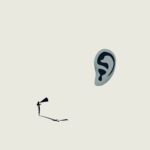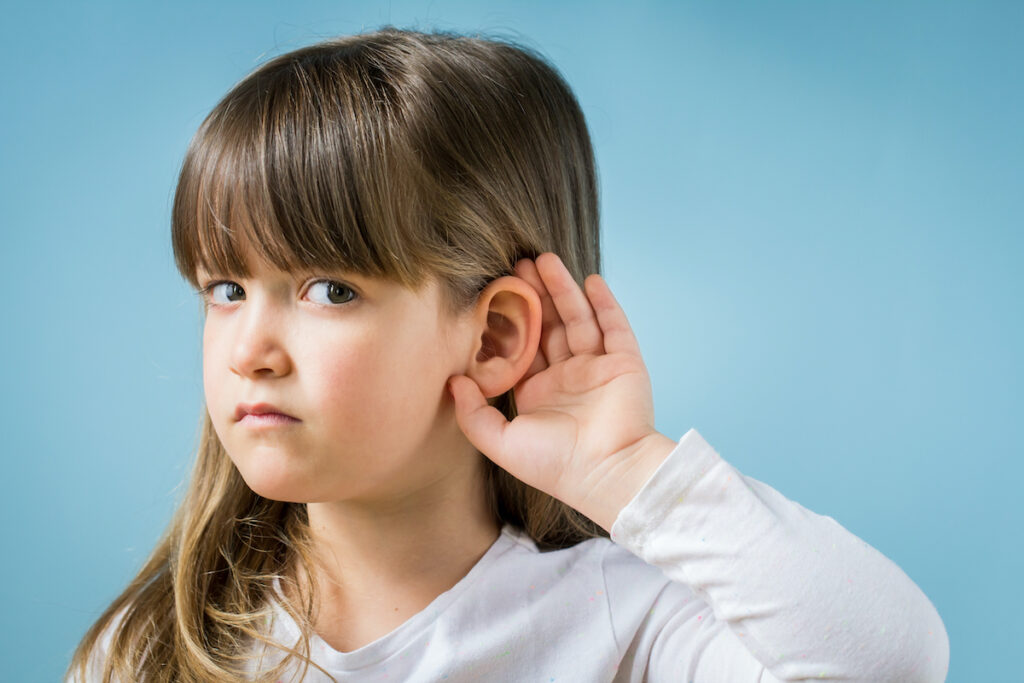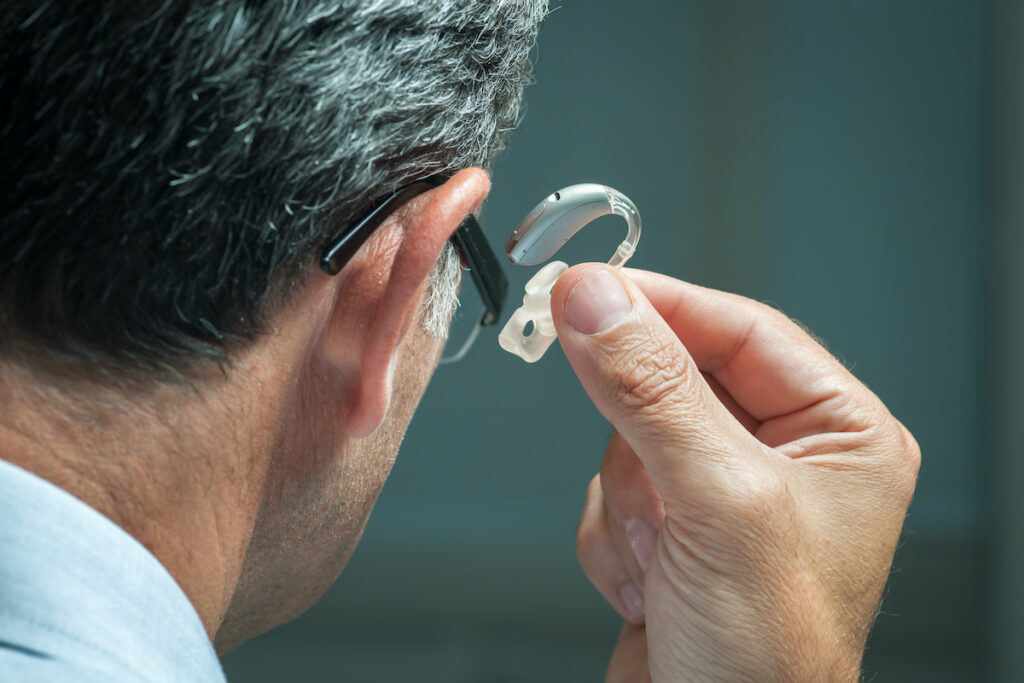
The experience of hallucinations in prelingually deaf people is a topic of interest and subject to wide debate. Hallucinations often occur visually and include verbal communication which poses a question as to the possible influence of language background on the content of hallucinations. The concept of auditory hallucinations in prelingually deaf people has both baffled and intrigued researchers and clinicians. However, there have been consistent reports of hearing voices by prelingually deaf individuals (Atkinson et al., 2007; Briffa, 1999; DuFeu & McKenna, 1999). There is significant debate about this concept; researchers either question (Schonauer et al., 1998; Basilier, 1964) or support (DuFeu & McKenna, 1999) the notion of true auditory hallucinations in prelingually deaf individuals. The most recent study has attempted to deconstruct the concept of voices (Atkinson et al., 2007).
Some professionals think sensory experiences may impact on how hallucinations are perceived (Atkinson et al., 2006, 2007). Deaf people vary widely in levels of hearing loss and some propose that hearing voices may be due to residual hearing. Another theory suggests that auditory hallucinations occur when individuals misinterpret their own inner voice to an external source (Frith & Done, 1986, 1988).
Tripp and Halder (2021) aimed to systematically review the literature to collate the content of hallucinations and how they are experienced by prelingually deaf people with psychosis, with consideration to individual sensory experiences.

There is significant debate about whether prelingually deaf people with psychosis hear voices.
Methods
The authors searched for papers to be included if they were written in English and examined how hallucinations are experienced and shaped by sensory experiences in prelingually deaf people with a diagnosis of schizophrenia. No restrictions were placed on publication status or date of published studies. No gender or age restrictions were placed on participants.
One author examined the quality of study designs. It is not clear whether a specific quality assessment tool was used to guide this assessment.
Results
Ten studies were included in this systematic review. Dates of published studies ranged from 1964 to 2007.
Experience of hallucinations
- Auditory and visual hallucinations were both reported by 7/10 studies. Four of which reported similar prevalence rates for both hallucination types, whereas, auditory hallucinations were slightly more prevalent than visual hallucinations in the other three studies.
- Somatic (internal bodily sensations) hallucinations were reported by 5/10 studies. Prevalence rates of somatic hallucinations in three studies were 19.4%, 23% and 47.1%.
- Olfactory (sense of smell) hallucinations were reported by 3/10 studies and occurred in 1.7%, 4.4% and 17.6% of the three study samples.
- Gustatory (sense of taste) hallucinations were reported by 2/10 studies. Of which, one study reported prevalence rates of 1.5%.
- Tactile (external bodily sensations) hallucinations were reported by 1/10 studies with a prevalence rate of 14.9% of the sample.
Content of hallucinations
- Religion was a common theme of hallucinations across 4 studies and were observed to occur alongside command hallucinations.
- Sexual content in hallucinations was noted by 2 studies and appeared to coincide with tactile and somatic hallucinations.
- Paranoia was present in delusions and hallucinations across two studies.
- Images of verbal communication (e.g., finger spelling, signing, and lip-reading) were reported by three studies.
- Audio-visual hallucinations appeared to criticise the individual across two studies.
Audio-visual hallucinations
- Audio-visual hallucinations were common across 9/10 studies. Reports across studies were inconsistent and reflect the ongoing debate about the concept of hearing voices in a deaf population.
- Five studies support the notion that deaf people can hear voices. Accounts and observations included hearing voices both with and without a hearing aid, distinguishing auditory from visual hallucinations (e.g., sign, lip-reading or identity), and placing emphasis on “hearing” voices by patients (e.g., finger-spelling “heard”).
- Four studies dispute that deaf patients heard voices. This is due to accounts of hearing voices through vibrations and air currents, reports of only the volume of a voice (e.g., felt sound pressure), and patients signing the word “hearing” to convey they have received meaningful information. Additionally, researchers have hypothesised that deaf patients report hearing voices as they misinterpret their internal monologue as an external voice. Three studies found that patients were unable to report the features of voices in detail.
- One study led by a deaf research team attempted to deconstruct the concept of voice-hearing. Pitch and volume of voices was described by moderate-severely deaf patients who used hearing aids. However, patients who were born deaf reported that the voices they hear do not make sounds, but are images in their mind signing or moving their lips.

This review demonstrates that audio-visual hallucinations among prelingually deaf people were commonly found in studies across five decades.
Conclusions
- Auditory, visual, somatic, olfactory, and tactile hallucinations were experienced by deaf people with psychosis, with audio-visual being the most prevalent type of hallucination
- The content of hallucinations was religious, paranoid, and/or sexual in nature
- It appears that clinicians and researchers need to consider both individual sensory experiences and preferred communication style (e.g., sign, lip-reading, hearing-aid, using or not using their voice) when assessing voice hearing in prelingually deaf people with psychosis.

Professionals need to consider both individual sensory experiences and preferred communication style when assessing voice hearing in prelingually deaf people with psychosis.
Strengths and limitations
A strength of the review was the authors’ systematic approach and comprehensive search across 9 databases. It was refreshing to see inclusion of unpublished literature as well, which could help to address the file-drawer problem we have in research. Although, it is unfortunately quite usual to see few studies conducted with deaf individuals, which is possibly why the search strategy was so broad. As such, an inherited limitation of the review is that most studies were old. Namely, the most recent study was conducted in 2007. This suggests that more up-to-date research is needed in this area to ensure that research is reflective of prelingually deaf people’s current experiences of psychosis.
Study quality was scrutinised throughout the discussion but there appeared to be no specific quality assessment tool used. Some transparency about what guided the quality assessment of studies would have been helpful. Additionally, the review acquired limitations of individual studies as there was a lack of data on different types of hallucinations to auditory or visual, and content of hallucinations. Strong emphasis was also placed by interviewers on questions about audio and visual hallucinations, which leads to queries about whether patients did not report different types of hallucinations or whether the interviewers did not ask directly about other hallucinatory experiences. This questions the validity of included studies and the review overall.
The overall sample of prelingually deaf people included was diverse in language background. For example, communication ranged from finger-spelling to signing. Language deprivation, which occurs when a deaf child was not provided with accessible language skills in their early years (Hall, 2017), is especially common in older deaf people due to historical oralist approaches in schools and parents told not to sign to their children if they were deaf (Conrad, 1980). Language deprivation may have affected the interviews with clinicians whereby deaf patients possibly nodded in agreement when they did not understand. Additionally, hallucinations are an abstract concept which is especially difficult to communicate for deaf people with language deprivation (Glickman, 2007).

Differing severities of language deprivation may have affected the interviews with deaf people with psychosis.
Implications for practice
There are similar prevalence rates for psychosis in both deaf and hearing people (Landsberger & Diaz, 2011). Deaf people with psychosis appear to have a higher prevalence rate of visual (50 – 83.3%) hallucinations compared to hearing populations with psychosis (37%; Critchley et al., 1981; DuFeu & McKenna, 1999; Evans & Elliott, 1981; Schonauer et al., 1998; van Ommen et al., 2016). This makes sense in the context of different communication and sensory needs for deaf and hearing populations with psychosis. For example, prelingually deaf people primarily use visual communication, whereas hearing people use a combination of auditory and visual communication (with more emphasis placed on auditory). Furthermore, communication needs, language deprivation, and accessibility of services, can create additional struggles for prelingually deaf people with psychosis. These struggles can lead to miscommunication and misdiagnosis when prelingually deaf people with psychosis have not been provided with appropriate, visual, and tailored, resources to help them to understand the questions asked or information given. Professionals and researchers also need to be better equipped to receive information from deaf patients as language deprivation can present similarly to disorganised thinking and language in psychosis (Glickman, 2007; Landsberger & Diaz, 2011).
It is a legal requirement that equal access to services is given for deaf people (Equality Act, 2010). Services should arrange for a BSL interpreter, trained specifically in mental health, to attend all appointments to ensure deaf clients fully understand what is being asked or provided to them. We, as professionals, should not assume a deaf person can lip-read and should consistently adapt our practice to suit the communication and language needs of the deaf individual. Moreover, it is important that clinicians and researchers ensure they are aware of and consider deaf/hearing identities, deaf culture/history, individual communication preferences and sensory needs to ensure assessment and intervention with prelingually deaf people with psychosis is tailored appropriately (and more generally when working with deaf people in mental health or health services). Also, we’d encourage professionals to seek advice from and/or signpost to specialist deaf mental health services about working with deaf people, instead of applying hearing norms to them.

Professionals need to be mindful of deaf culture and history, and work closely with mental health trained BSL interpreters.
Statement of interests
None.
Links
Primary paper
Tripp, E., & Halder, N. (2021). A systematic review of the content and modality of hallucinations in prelingually deaf people with schizophrenia (PDF). International Journal on Mental Health and Deafness, 5(1), 102 – 117.
Other references
Atkinson, J. R. (2006). The perceptual characteristics of voice-hallucinations in deaf people: insights into the nature of subvocal thought and sensory feedback loops (PDF). Schizophrenia bulletin, 32(4), 701 – 708.
Atkinson, J. R., Gleeson, K., Cromwell, J., & O’Rourke, S. (2007). Exploring the perceptual characteristics of voice-hallucinations in deaf people (PDF). Cognitive neuropsychiatry, 12(4), 339 – 361.
Basilier, T. (1964). SURDOPHRENIA: The psychic consequences of congenital or early acquired deafness. Some theoretical and clinical considerations. Acta Psychiatrica Scandinavica, 39(S180), 363 – 372. [Pubmed Abstract; no abstract available]
Briffa, D. (1999). Hallucinations in deaf people with a mental illness: lessons from the deaf clients. Australasian Psychiatry, 7(2), 72 – 74. [Abstract]
Conrad, R. (1980). Let the children choose. International Journal of Pediatric Otorhinolaryngology, 1(4), 317 – 329.[Abstract]
Critchley, E., Denmark, J. C., Warren, F., & Wilson, K. A. (1981). Hallucinatory experiences of prelingually profoundly deaf schizophrenics. The British Journal of Psychiatry, 138(1), 30 – 32. [Abstract]
DuFeu, M., & Mckenna, P. (1999). Prelingually profoundly deaf schizophrenic patients who hear voices: a phenomenological analysis. Acta Psychiatrica Scandinavica, 99(6), 453 – 459. [Pubmed Abstract]
Evans, J. W., & Elliott, YH. (1981). Screening criteria for the diagnosis of schizophrenia in deaf patients. Archives of General Psychiatry, 38(7), 787 – 790. [Abstract]
Frith, C. D., & Done, D. J. (1986). Routes to action in reaction time tasks (PDF). Psychological research, 48(3), 169 – 177.
Frith, C. D., & Done, D. J. (1988). Towards a neuropsychology of schizophrenia. The British Journal of Psychiatry, 153(4), 437 – 443. [Pubmed Abstract]
Glickman, N. (2007). Do you hear voices? Problems in assessment of mental status in deaf persons with severe language deprivation (PDF). Journal of deaf studies and deaf education, 12(2), 127–147.
Hall, W. C. (2017). What You Don’t Know Can Hurt You: The Risk of Language Deprivation by Impairing Sign Language Development in Deaf Children (PDF). Maternal and Child Health Journal, 21(5), 961 – 965.
Landsberger, S. A., & Diaz, D. R. (2011). Identifying and Assessing Psychosis in Deaf Psychiatric Patients. Current Psychiatry Reports, 13, 198 – 202. [Pubmed Abstract]
Schonauer, K., Achtergarde, D., Gotthardt, U., & Folkerts, H. (1998). Hallucinatory modalities in prelingually deaf schizophrenic patients: a retrospective analysis of 67 cases. Acta Psychiatrica Scandinavica, 98(5), 377 – 383. [Pubmed Abstract]
Van Ommen, M., Van Beilen, M., Cornelissen, F., Smid, H., Knegtering, H., Aleman, A., & Van Laar, T. (2016). The prevalence of visual hallucinations in non-affective psychosis, and the role of perception and attention. Psychological Medicine, 46(8), 1735-1747. [Pubmed Abstract]

Excellent Review on A halls in prelinguistic patients with Schizophrenia
I am a Psychiatrist on a teaching service. This is a great resource for my Residents and Medical Students on the Service